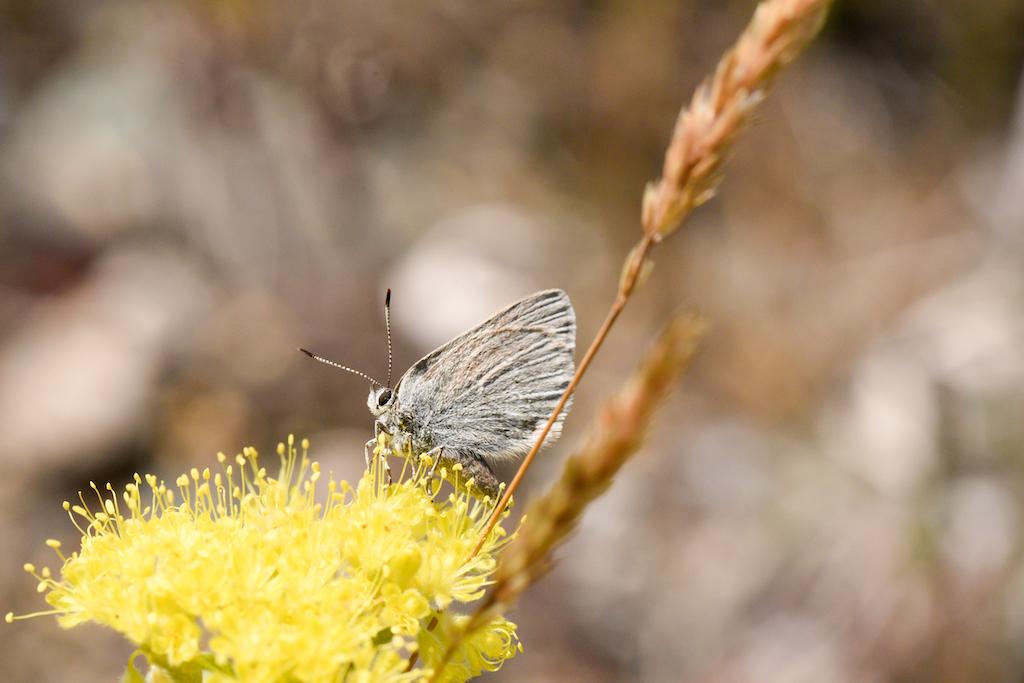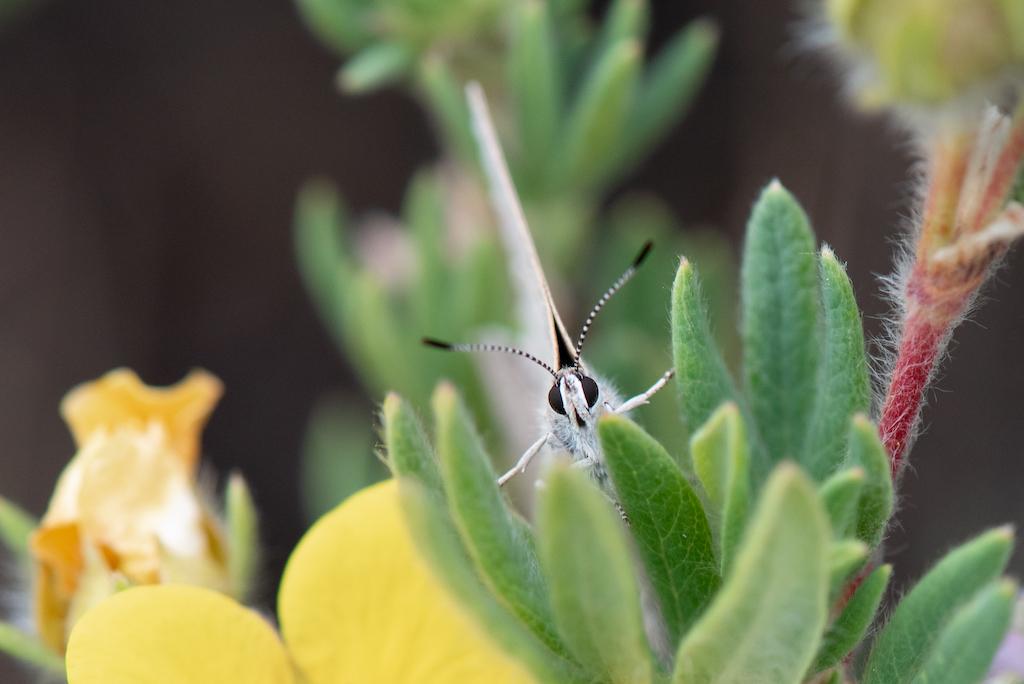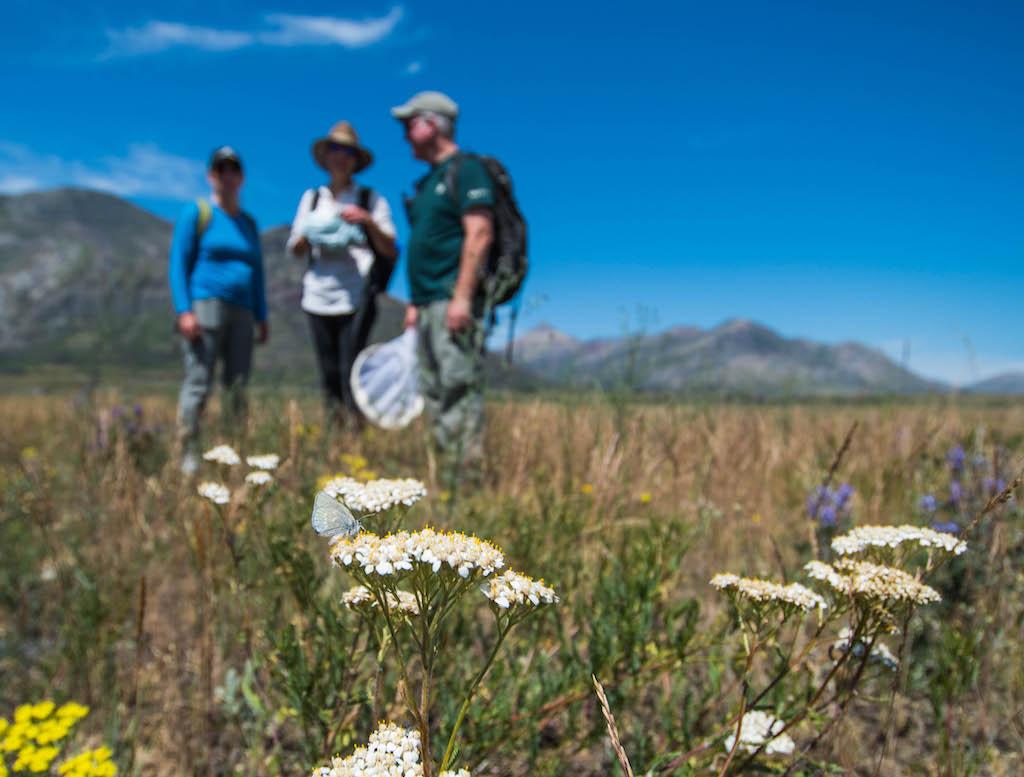
A deceptively plain half-moon hairstreak butterfly sits on a plant in Waterton Lakes National Park/Courtesy of Calgary Zoo
The half-moon hairstreak may officially be listed as “a small, drab butterfly,” but it’s also endangered and can only be found in eight spots in British Columbia and just one location in Alberta. At Waterton Lakes National Park, the isolated population numbers in the hundreds.
Parks Canada has just announced funding for a three-year plan that will see Waterton Lakes and the Calgary Zoo team up to study the secretive life history of the rare butterfly, understand its genetics, restore its habitat and nurture its survival.
“It’s a small, brownish-grey butterfly so it’s easily overlooked,” Robert Sissons, Waterton’s ecologist for restoration and vegetation, said in a phone interview. “It doesn’t have the gaudy colour of other butterflies — but I don’t think it needs it.” When he studies it closely in the field, gazing into its big black eyes and admiring its fuzzy head, “it’s a very charming little butterfly.”
The half-moon hairstreak (Satyrium semiluna) calls a tiny portion of the national park home. It gravitates to Blakiston Fan, a grassland area along the entrance road that was named for an early explorer. The area is an alluvial fan, a fan-shaped deposit of gravel, sand and silt that was created and maintained by Blakiston Creek. In spring, the fan is carpeted with wildflowers. In fall and winter, it’s home to elk and other wildlife. Soils drain quickly here but the area has a meandering river and is threatened by flooding and occasional natural or man-made fires.
The butterfly’s biggest threat is spotted knapweed, an invasive species that’s on the rise in the park and suppressing the native plants it needs for food, shelter and breeding. The half-moon hairstreak lays its greenish-white eggs on silky and silvery lupines each summer, and its newborn light green caterpillars feast on the same wildflowers the next spring. Nectar from yellow buckwheat and Missouri goldenrod are also key food sources. In their adult form, the butterflies live six to 14 days.

A close look at the compelling face of a half-moon hairstreak butterfly in Waterton Lakes National Park/Courtesy of Calgary Zoo
“The population emerges in late July and peaks in early to late August,” Sissons said. “It’s timed to when the yellow buckwheat it needs for nectar emerges and flowers.” Butterflies are a prey species and a pollinator. Diverse populations show that ecosystems are healthy and flourishing.
Sissons said surveys between 2003 and 2018 showed a drastic decline in Waterton’s half-moon hairstreak population. “In the span of a decade, we’ve gone from thousands to hundreds.”
The Species at Risk Act (SARA) declared the butterfly — which it describes as drab — endangered in April 2006. In December 2016, it identified and legally protected the butterfly’s critical habitat within Waterton. Under the act, Parks Canada is responsible for the protection and recovery of listed species across its network of protected areas. It collaborates with academic and expert partners and uses cutting-edge research techniques on this mission.
Funding of $289,000 ($228,000 USD) for the three-year collaboration between Parks Canada and the Calgary Zoo was announced this week by Minister of Environment and Climate Change Jonathan Wilkinson, who is also minister responsible for Parks Canada. "National parks play an important role in addressing the impacts of climate change, protecting our biodiversity and contributing to the recovery of species at risk,” he noted in a news release.
Clément Lanthier, president and CEO of the Calgary Zoo, said the zoo will bring its applied science expertise to the project. “This tiny and humble butterfly may not be in the spotlight as much as some species, but their existence is a valuable and intrinsic part of Canada's rich biodiversity,” he noted.
The half-moon hairstreak — named for the ranch in Wyoming where it was first identified as a species — is light brown with indistinct white-ringed black spots on its wings. It has no "tail" on the hindwing, unlike other species of hairstreaks. Males have the wingspan of a Canadian loonie (about one inch).
In the United States, its range extends south to California, and east to Wyoming and Texas. The northern range extends into Alberta and British Columbia, where it’s under severe pressure from development as well as invasive weeds.

A half-moon hairstreak butterfly sits on a plant in Waterton Lakes National Park as Parks Canada and Calgary Zoo researchers look on/Parks Canada
Waterton researchers plan to study the butterfly’s life stages, survival rates, larval behavior, interactions with ants and egg over-wintering conditions. On the conservation front, they’ll assess and restore its habitat and manage invasive plants.
The collaboration began last summer and promises to advance longer-term population monitoring and will involve collecting genetic material to see whether it might be possible to do wild-to-wild translocations of butterflies in British Columbia or Montana. Those populations are 400 kilometres (250 miles) away and will never naturally mix.
Capturing and raising some half-moon hairstreaks at the zoo is possible, said Sissons, but captive rearing of endangered species is always a last resort. Given that the Waterton population “has probably been isolated for many centuries in a unique environment,” it’s also possible researchers will discover it’s actually a sub-species.
In Waterton, the Blakiston Fan Is open to visitors, but Sissons asks for everyone to stay on informal trails and horse paths “as much as possible and not trample flowers” or lie in the blooming fields to take selfies. Volunteers can take part in knapweed control and help plant native plants.
Waterton Lakes is in southwest Alberta and is part of the Waterton-Glacier International Peace Park, created to promote goodwill between Canada and the United States, underscore the international nature of wilderness and the co-operation required in its protection. Waterton covers 505 square kilometres, or about 195 square miles. Sissons estimates that the half-moon hairstreak’s tiny home in Blakiston Fan is about 250 hectares (617 acres).



Comments
Hi, I was wondering if you could link me to any peer-reviewed journal articles that discuss the life history and biology of half-moon hairstreaks?
Thanks!